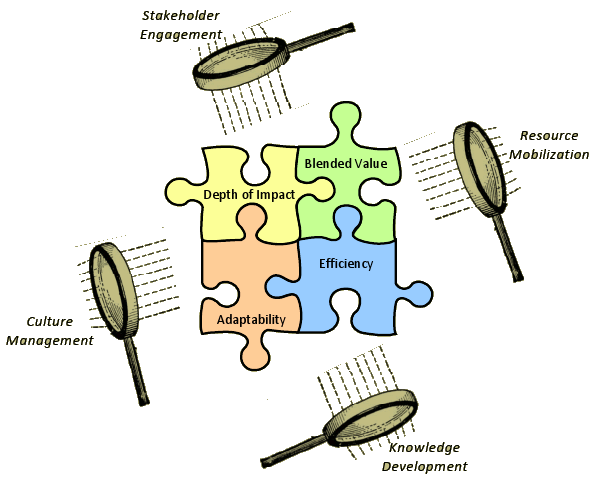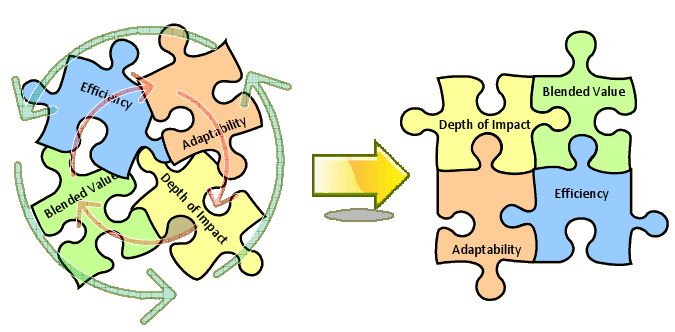Part 3: The Case for Integration
Part 3: The Case for IntegrationIdentifying Common Strategic Lenses
Identifying Common Strategic LensesWe have seen that performance (good, bad and neutral) can be traced to a series of common challenges relating to the four performance criteria outlined above.
Although the particulars of these challenges are naturally wide ranging, depending on the nature of the social problem and the operating environment, most challenges call for actions in four common strategic areas: Stakeholder Engagement, Resource Mobilization, Knowledge Development, and Culture Management.
These four central themes—we call strategic lenses—highlight a series of strategic questions common to all social sector organizations.

| Strategic Lens | Central Theme | Core Strategic Questions |
|---|---|---|
| Stakeholder Engagement | A stakeholder is anyone who has a role to play in addressing the social problem (i.e. community, clients, donors, staff/ management, board, environment, public, etc.). |
|
| Resource Mobilization | Resources can be:
|
|
| Knowledge Development | Knowledge is the combination of information (content, results from research, data) and processes (methodologies, systems, techniques, procedures). |
|
| Culture Management | Culture results from the combination of the many belief systems and mindsets found among stakeholder groups. |
|
Social Enterprise: Assessing and Delivering Performance through the Four Strategic Lenses
Social Enterprise: Assessing and Delivering Performance through the Four Strategic LensesNow that we have identified performance criteria and critical strategic areas common to social sector organizations, we can start examining the interplay between strategic actions and performance, and how the two together can lead to sustainable social impact. The construct of strategic questions related to each strategic lens and cross-referenced with performance questions can be used to create a diagnostic tool to assess social enterprise performance.
Performance assessment through Four Strategic Lenses highlights unrealized opportunities to increase performance, indicates weaknesses and pinpoints conflicts that may detract from achieving performance objectives. Once social enterprises performance is assessed, its leaders can decide which strategic actions should be pursued to enhance or improve performance in pursuit of sustainable social impact.
Assessment can be conducted formally and comprehensively and used to inform periodic strategic planning with ongoing performance monitoring . However, the true strength of the Four Lenses Framework to deliver high performance lies in its potential to be incorporated into daily social enterprise management practice and decision making. Constant vigilance, rather than episodic attention, is required for a social enterprise to attain and maintain a sustainable social impact.

The chart above and table following illustrates the relationships between the strategic lenses and performance criteria, and therefore the synergies and tensions within the lenses themselves. Its important to note that social sector organizations are dynamic. Although the depiction in the chart gives each of the lenses equal weight, weights can shift depending on the relative importance of what is going on within the organization or how the organization is affected by what is going on in the external environment. Practitioners may concentrate on improving the social enterprise performance of one lens given the urgency or timeliness of internal factors (deficit, new leadership, stakeholder resistance, etc) or external factors (emergent competition, partnership opportunity, etc.).
The Four Lenses and their relationship to performance function like clockworks: adjustments in one lens to improve performance creates the need for tinkering in other lenses. As suggested by current social enterprise theory, a focus on one dimension of performance (historically these were leadership, funding, program) in and of itself does not achieve sustainable social impact. Social enterprise performance objectives are attained by comprehensive management of all strategic lenses (though one or more may take priority at a particular time) as well as the interplay between the lenses. In short, high performance cannot be achieved if actions and decision making in one or more of the strategic lenses are neglected.
| Performance Criteria | Primary lens through which performance is delivered… | Secondary lenses further enhancing or hindering performance… | Depth of Impact | How successful are we at engaging all stakeholders deeply and durably? | How do our culture, resources and knowledge support (or hinder) a deeper stakeholder engagement? |
|---|---|---|
| Blended Value | How successful are we at mobilizing resources in an integrated, viable and renewable manner? | How do our knowledge, stakeholders and culture support (or hinder) viable resource mobilization? |
| Efficiency | How successful are we at developing knowledge that leads to more appropriate processes? | How do our resources, culture and stakeholders support (or hinder) the development of appropriate processes? |
| Adaptability | How successful are we at creating a culture that supports initiative and reduces resistance to change? | How do our stakeholders knowledge and resources support (or hinder) a culture of change and initiative? |
The Rubik's Pyramid Challenge
The Rubik's Pyramid ChallengeThe framework offers one explanation for why sustainable social impact appears much easier to achieve than it actually is! Although it looks like a simple puzzle when we sign up for it, achieving sustainable social impact actually requires solving a Rubik’s Pyramid.
From a simple puzzle…

… to a Rubik’s pyramid!

In a Rubik's Pyramid, each of the four faces is covered by nine small triangles, divided among four solid colors. A pivot mechanism enables each face to turn independently, thus mixing up the colors. For the puzzle to be solved, each face must be a solid color.
The four lenses are like the side of the pyramid: trying to “solve” one without the others is counter-productive. Instead, all four need to be addressed in an integrated manner to solve the puzzle.